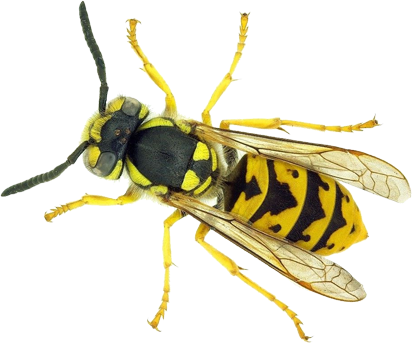Las Avispas
Next, we will explore the fascinating world of wasps and their importance in our natural environment. We will learn about its biology, characteristics and behavior, as well as its role in the ecosystem.
We will also address concerns associated with wasps and the need for proper control when their presence poses a danger.
eliminate wasps - fumigate wasps - treatment against wasps
Dangers or risks of wasps in our environment

Allergic reactions and bites
Wasps can pose a danger due to the following reasons:
- Painful stings: Wasps have a poisonous sting and their sting can be very painful for people. Additionally, some people may have severe allergic reactions to wasp stings. Serious allergies: For some people, a wasp sting can trigger a severe allergic reaction known as anaphylaxis, which requires immediate medical attention.
Danger to public safety
Wasps can also pose a public safety hazard due to:
- Nests in high-traffic areas: If a wasp nest is located near busy areas, such as parks or schools, people are at risk of being attacked if the wasps feel threatened. Interference with outdoor activities: The presence of wasps You can limit outdoor activities, such as eating on terraces or enjoying gardens, as people fear bites.
Types of wasps in Alicante
Common wasp (Vespula vulgaris)
The common wasp is a species widely distributed in Alicante. They are medium in size, usually with distinctive yellow and black colors. They build paper nests in protected areas, such as trees or buildings.
Germanic wasp (Vespula germanica)
The Germanic or yellow jacket wasp is another common species in Alicante. They are similar in appearance to the common wasp, with yellow and black colors, but they are usually larger. They build nests underground or in natural cavities.
European Avispón (Vespa crabro)
The European hornet is a larger species than common wasps. They have a robust body, yellow and brown colors and a wide head. Their nests can be found in hollow trees or abandoned structures.
Do you have a wasp problem?
Contact us. We are experts in treatments to fumigate wasps, both in gardens and around the pool.
More than 40 years of experience support us.
OR GIVE US A CALL
965 952 750
Professional treatments to eliminate wasps
Removal of wasp nests or wasp nests should be carried out by trained pest control professionals. Some methods used include:
01
Identification and evaluation
Pest control experts will inspect the location and type of wasp nest to determine the best removal strategy.
02
Tratamientos químicos
Specific products are applied to control and eliminate wasps and their nests, guaranteeing the safety of people and minimizing the impact on the environment.
03
Exclusion and prevention
In addition to removing existing nests, it is recommended to take steps to prevent future infestations, such as sealing potential entry points and eliminating sources of wasp attraction.

Tips, Remedies and Frequently Asked Questions About Wasps
Si después de leer esta página tienes más preguntas o necesitas ayuda profesional, contacta con una empresa de control de plagas especializada en la eliminación de avispas, como Higienisa






